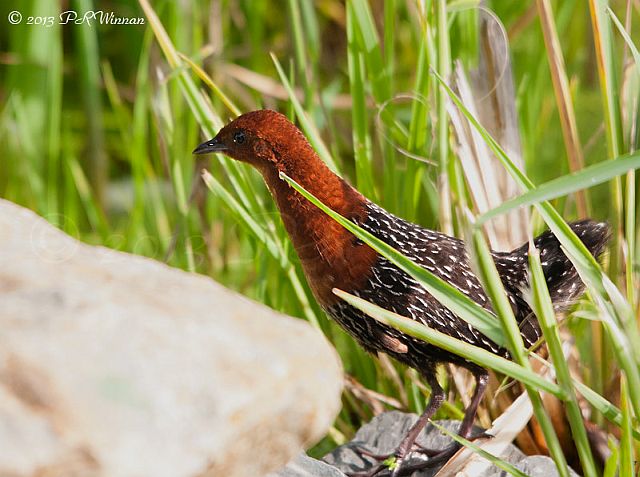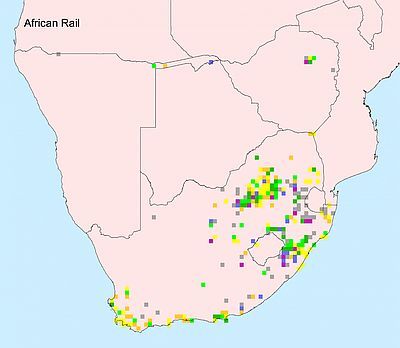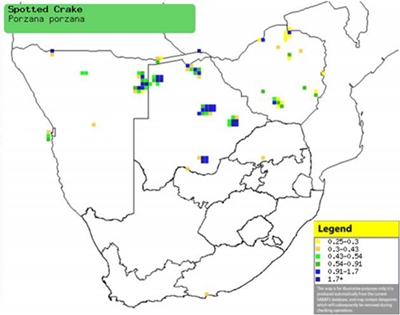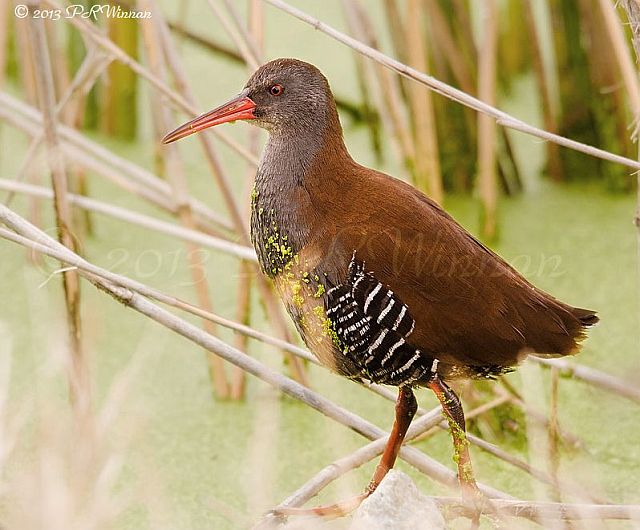217. Red-chested Flufftail Sarothrura rufa (Rooiborsvleikuiken)
Order: Gruiformes. Family: Sarothruridae
Description
16 cm. A small compact bird with short, rounded wings and a slender bill. All-black body, wings and tail.
The male has a rufous head and lower breast. Rest of plumage black with narrow white streaks and small white spots on the tail.
The female’s colouration is dark brown above, spotted or lightly barred buff, brown below scaled and barred buff, with whitish throat and belly.
Immature resembles female, but plainer and darker.
Similar species: In flight it is distinguished from Striped Flufftail by its black. Striped Flufftail Sarothrura affinis has an all-chestnut tail (in both sexes). Also similar to Buff-spotted Flufftail, but re coulouring of the Red-chested Flufftail male extends onto mantle and lower breast. Female is much darker, but paler on throat.
Taxonomy
There are three subspecies:
S. r. bonapartii - Sierra Leone to Gabon and Congo
S. r. elizabethae - C African Rep. to ne DRC, Ethiopia, Uganda and w Kenya
S. r. rufa - Central Kenya to s DRC, Angola and South Africa
Distribution
Occurs in patches of sub-Saharan Africa, from Sierra Leone to Ethiopia south to southern Africa. In southern Africa it is locally common in northern Botswana, the Caprivi Strip (Namibia), Zimbabwe, central and southern Mozambique and eastern and south-western South Africa.
Habitat
It generally prefers marshy, freshwater habitats with permanently dense cover, such as swamps, wet grassland, vleis, marshes, streams, lakes, ponds, dams and rivers with dense riparian vegetation.
Movements and migrations
Adults are largely resident, making local movements in the non-breeding season, while juveniles disperse from their parents' territories after becoming independent.
Diet
It forages on the ground, probing the mud and vegetation in search of prey. Its diet consists predominantly of invertebrates such as earthworms, small gastropods, spiders, adult and larval insects (e.g. termites, small ants, Diptera, aquatic and terrestrial Hemiptera, and Coleoptera) and crustaceans (e.g. amphipods). Grass seeds may also form part of diet during the non-breeding season.
Breeding
Monogamous, territorial solitary nester with a life-long pair bond, although males may force copulation with other females in the breeding season. The nest is built solely by the female, consisting of a cup of grass or dead plants, sometimes with a partial canopy or dome made of live stems. It is typically placed in clump of grasses such as wild rice (Oryza perennis) and Bedding grass (Pennisetum macrourum), often waterlogged at the edge of marshy areas. Egg-laying season is from September-May. It lays 2 or 3 oval, white eggs, which are incubated by both sexes for about 14-18 days, with the male taking the day shift while the female incubates at night. The chicks leave the nest within 2-3 days of hatching, brooded regularly under the wings the female, with both parents feeding them on insects and other invertebrates. They typically become independent at about 3-4 weeks old, taking their first flight 2-3 weeks later, although they may solicit food from the parents for some time after this.
Call
Its call is a low far carryingooouup-oooup and a klee-klee-klee-klee.
Status
Fairly common resident.
Africa Wild Bird Book
Red-chested Flufftail Photos
217. Red-chested Flufftail Sarothrura rufa (Rooiborsvleikuiken)
 © PRWIN
© PRWIN
Male. Marievale Bird Sanctuary, Gauteng
Links:
Sabap2
Species Text Sabap1
Newman's Birds of Southern Africa
 © PRWIN
© PRWINMale. Marievale Bird Sanctuary, Gauteng
Links:
Sabap2
Species Text Sabap1
Newman's Birds of Southern Africa
Family Rallidae (Rails, Crakes and Coots)
The rails, or Rallidae, are a large cosmopolitan family of small- to medium-sized birds. The family exhibits considerable diversity and also includes the crakes, coots, and gallinules. Many species are associated with wetlands, although the family is found in every terrestrial habitat except dry deserts, polar regions, and alpine areas above the snow line. Members of the Rallidae occur on every continent except Antarctica. The most common rail habitats are marshland or dense forest. They are especially fond of dense vegetation.
The rails are a fairly homogeneous family of small to medium sized ground living birds. They vary in length from 12 cm to 63 cm. Some species have long necks and in many cases are laterally compressed. The bill is the most variable feature within the family: in some species it is long, in others it may be short and wide (as in the coots), or massive (as in the purple gallinules). In the Old World, long-billed species tend to be called rails and short-billed species crakes. A few coots and gallinules have a frontal shield, which is a fleshy rearward extension of the upper bill. Rails exhibit very little sexual dimorphism in either plumage or size.
In general, members of Rallidae are omnivorous generalists. Many species eat invertebrates, as well as fruit or seedlings.
The most typical family members occupy dense vegetation in damp environments near lakes, swamps, or rivers. Reed beds are a particularly favoured habitat.
Most nest in dense vegetation. In general, they are shy, secretive, and difficult to observe. Most species walk and run vigorously on strong legs, and have long toes that are well adapted to soft, uneven surfaces. They tend to have short, rounded wings and although they are generally weak fliers, they are, nevertheless, capable of covering long distances.
The rails are a fairly homogeneous family of small to medium sized ground living birds. They vary in length from 12 cm to 63 cm. Some species have long necks and in many cases are laterally compressed. The bill is the most variable feature within the family: in some species it is long, in others it may be short and wide (as in the coots), or massive (as in the purple gallinules). In the Old World, long-billed species tend to be called rails and short-billed species crakes. A few coots and gallinules have a frontal shield, which is a fleshy rearward extension of the upper bill. Rails exhibit very little sexual dimorphism in either plumage or size.
In general, members of Rallidae are omnivorous generalists. Many species eat invertebrates, as well as fruit or seedlings.
The most typical family members occupy dense vegetation in damp environments near lakes, swamps, or rivers. Reed beds are a particularly favoured habitat.
Most nest in dense vegetation. In general, they are shy, secretive, and difficult to observe. Most species walk and run vigorously on strong legs, and have long toes that are well adapted to soft, uneven surfaces. They tend to have short, rounded wings and although they are generally weak fliers, they are, nevertheless, capable of covering long distances.
Family Rallidae (Rails, Crakes and Coots) Index
Species indigenous to southern Africa:
Family Rallidae (Rails, Crakes and Coots)
Rallus caerulescens African Rail 210
Crecopsis egregia African Crake 212
Crex crex Corn Crake 211
Amaurornis flavirostra Black Crake 213
Zapornia pusilla Baillon's Crake 215
Porzana porzana Spotted Crake 214
Aenigmatolimnas marginalis Striped Crake 216
Porphyrio madagascariensis African Swamphen 223
Porphyrio alleni Allen's Gallinule 224
Porphyrula martinica American Purple Gallinule 225
Gallinula chloropus Common Moorhen 226
Gallinula angulata Lesser Moorhen 227
Fulica cristata Red-knobbed Coot 228
Family Rallidae (Rails, Crakes and Coots)
Rallus caerulescens African Rail 210
Crecopsis egregia African Crake 212
Crex crex Corn Crake 211
Amaurornis flavirostra Black Crake 213
Zapornia pusilla Baillon's Crake 215
Porzana porzana Spotted Crake 214
Aenigmatolimnas marginalis Striped Crake 216
Porphyrio madagascariensis African Swamphen 223
Porphyrio alleni Allen's Gallinule 224
Porphyrula martinica American Purple Gallinule 225
Gallinula chloropus Common Moorhen 226
Gallinula angulata Lesser Moorhen 227
Fulica cristata Red-knobbed Coot 228
-
Sharifa
African Rail
210. African Rail Rallus caerulescens (Grootriethaan)
Order: Gruiformes. Family: Rallidae
Description
Larger than a dove. 28-30 cm. Moves jerkily, continuously flicking its tail. May swim. The long red bill is diagnostic. The legs, feet and the eyes are red. The upperparts are dark brown, foreneck and breast dark grey, the flanks and the undertail are black barred white and the face isslate-grey. Sexes are similar.
Female: Shorter billed and with markings slightly less distinctive.
Juvenile: Duller than the adult, appearing more brown, the blue-grey is replaced by buff. The precocial downy chicks are black, as with all rails.
Similar species: Like the African Crake and Baillon's Crake, the African Rail has a grey throat and breast but is larger than each of those species and has a diagnostic long, red, decurved bill.
Distribution
Occurs from Ethiopia south through Uganda, Kenya, southern DRC, Tanzania, eastern Angola and Zambia to southern Africa. Here it is uncommon to locally common in the Caprivi Strip (Namibia), northern Botswana, Zimbabwe, southern Mozambique and patches of South Africa, largely excluding the Northern Cape, Free State and Eastern Cape.

Habitat
A shy skulking bird that usually keeps to its habitat of reed beds and marshes, but may be seen out in the open, especially in the morning. It generally prefers reedbeds and other dense vegetation along the edges of swamps, streams and marshes, sometimes moving to paddy fields and seasonally wet sugar cane fields next to marshes.
Diet
Mainly eats insects, earthworms, spiders, insects, aquatic animals, small fish and some plant matter. It forages in mud or shallow water along the edges of reedbeds, probing in search of prey.
Breeding
Monogamous, solitary nester, establishing a territory at the onset of the breeding season in July and June by fighting with other pairs. The nest is a shallow saucer of leaves, sedge stems, Bulrushes (Typha capensis) and grasses, hidden in emergent vegetation above water, typically concealed within or between grass or sedge tufts. Egg-laying season is from July-May, peaking from September-February. It lays 2-6 heavily-spotted creamy-white eggs, which are incubated by both sexes for about 20 days. The chicks leave the nest soon after hatching, becoming fully independent when they fledge at 42-56 days old.
Call
Territorial call is a high pitched piping trill treee-tee-tee-tee-tee given by both sexes. Listen to Bird Call.
Status
A common resident.
Order: Gruiformes. Family: Rallidae
Description
Larger than a dove. 28-30 cm. Moves jerkily, continuously flicking its tail. May swim. The long red bill is diagnostic. The legs, feet and the eyes are red. The upperparts are dark brown, foreneck and breast dark grey, the flanks and the undertail are black barred white and the face isslate-grey. Sexes are similar.
Female: Shorter billed and with markings slightly less distinctive.
Juvenile: Duller than the adult, appearing more brown, the blue-grey is replaced by buff. The precocial downy chicks are black, as with all rails.
Similar species: Like the African Crake and Baillon's Crake, the African Rail has a grey throat and breast but is larger than each of those species and has a diagnostic long, red, decurved bill.
Distribution
Occurs from Ethiopia south through Uganda, Kenya, southern DRC, Tanzania, eastern Angola and Zambia to southern Africa. Here it is uncommon to locally common in the Caprivi Strip (Namibia), northern Botswana, Zimbabwe, southern Mozambique and patches of South Africa, largely excluding the Northern Cape, Free State and Eastern Cape.

Habitat
A shy skulking bird that usually keeps to its habitat of reed beds and marshes, but may be seen out in the open, especially in the morning. It generally prefers reedbeds and other dense vegetation along the edges of swamps, streams and marshes, sometimes moving to paddy fields and seasonally wet sugar cane fields next to marshes.
Diet
Mainly eats insects, earthworms, spiders, insects, aquatic animals, small fish and some plant matter. It forages in mud or shallow water along the edges of reedbeds, probing in search of prey.
Breeding
Monogamous, solitary nester, establishing a territory at the onset of the breeding season in July and June by fighting with other pairs. The nest is a shallow saucer of leaves, sedge stems, Bulrushes (Typha capensis) and grasses, hidden in emergent vegetation above water, typically concealed within or between grass or sedge tufts. Egg-laying season is from July-May, peaking from September-February. It lays 2-6 heavily-spotted creamy-white eggs, which are incubated by both sexes for about 20 days. The chicks leave the nest soon after hatching, becoming fully independent when they fledge at 42-56 days old.
Call
Territorial call is a high pitched piping trill treee-tee-tee-tee-tee given by both sexes. Listen to Bird Call.
Status
A common resident.
-
Sharifa
Spotted Crake
214. Spotted Crake Porzana porzana
Order: Gruiformes. Family: Rallidae
Description
21 - 24cm. Sexes are similar. White spots on the breast, neck and upper parts are distinctive. The bill is predominantly yellow with orange/red at the base of the upper mandible. Juveniles are less spotted and lack the grey on the breast. In flight, it shows a distinctive white leading edge to the wing. When on the ground, the bird flicks its tail, showing the buffy undertail coverts.
Distribution
They have an extremely large range with breeding birds occurring in Europe, Central Siberia and Iran. They winter in Southern Europe, the Middle East, southern Asia and Africa. In Africa they are most abundant in Zambia, Zimbabwe, Malawi and probably Mozambique. Generally uncommon in southern Africa, especially South Africa.

Habitat
Favours dense or flooded wetland margins.
Movements and migrations
A Palearctic migrant, breeding from Europe eastward to Central Siberia and Iran, and flying south to winter in Southern Europe, the Middle East, southern Asia and Africa. They normally arrive in south-central Africa from mid-December, peaking in January - March, and leaving before the end of April.
Diet
Small aquatic invertebrates, insect adults and larvae, small fish, plant matter and seeds.
Breeding
The nest is a thick-walled cup of plant matter, usually placed in thick vegetation near or over standing water, or alternatively in a tussock, or built up well above the water level. They lay 6 - 15 eggs.
Call
Usually silent in Africa. Male utters sharp whitt notes.
Status
Rare summer visitor.
Order: Gruiformes. Family: Rallidae
Description
21 - 24cm. Sexes are similar. White spots on the breast, neck and upper parts are distinctive. The bill is predominantly yellow with orange/red at the base of the upper mandible. Juveniles are less spotted and lack the grey on the breast. In flight, it shows a distinctive white leading edge to the wing. When on the ground, the bird flicks its tail, showing the buffy undertail coverts.
Distribution
They have an extremely large range with breeding birds occurring in Europe, Central Siberia and Iran. They winter in Southern Europe, the Middle East, southern Asia and Africa. In Africa they are most abundant in Zambia, Zimbabwe, Malawi and probably Mozambique. Generally uncommon in southern Africa, especially South Africa.

Habitat
Favours dense or flooded wetland margins.
Movements and migrations
A Palearctic migrant, breeding from Europe eastward to Central Siberia and Iran, and flying south to winter in Southern Europe, the Middle East, southern Asia and Africa. They normally arrive in south-central Africa from mid-December, peaking in January - March, and leaving before the end of April.
Diet
Small aquatic invertebrates, insect adults and larvae, small fish, plant matter and seeds.
Breeding
The nest is a thick-walled cup of plant matter, usually placed in thick vegetation near or over standing water, or alternatively in a tussock, or built up well above the water level. They lay 6 - 15 eggs.
Call
Usually silent in Africa. Male utters sharp whitt notes.
Status
Rare summer visitor.
Spotted Crake Photos
214. Spotted Crake Porzana porzana
 © Flutterby
© Flutterby
Waterfall Country Estate, Gauteng



Links:
Species text Sabap1: http://sabap2.adu.org.za/docs/sabap1/214.pdf
Sabap2
Newman's Birds of Southern Africa
 © Flutterby
© FlutterbyWaterfall Country Estate, Gauteng



Links:
Species text Sabap1: http://sabap2.adu.org.za/docs/sabap1/214.pdf
Sabap2
Newman's Birds of Southern Africa
- Flutterby
- Posts: 44029
- Joined: Sat May 19, 2012 12:28 pm
- Country: South Africa
- Location: Gauteng, South Africa
- Contact:
African Crake
212. African Crake Crecopsis egregia (Afrikaanse Riethaan )
Order: Gruiformes. Family: Rallidae
Description
20-23 cm. Heavily mottled upperparts and boldly barred underparts distinctive. It has brown-streaked blackish upperparts, bluish-grey underparts and black-and-white barring on the flanks and belly. It has a stubby red bill, red eyes, and a white line from the bill to above the eye.
Similar species: It is smaller than its closest relative, the Corn Crake; that species is also lighter-plumaged, and has an eye stripe.
Distribution
Occurs across sub-Saharan Africa; in southern Africa it is locally common in Zimbabwe, northern and eastern Botswana, north-eastern Namibia (including the Caprivi Strip), north-eastern South Africa and central and southern Mozambique.

Habitat
It generally prefers dry grassland in savanna, also moving into rice, sugar cane, maize and cotton fields, abandoned agricultural land and airfields.
Movements and migrations
Intra-African breeding migrant, breeding in southern Africa from October to April before heading north to its non-breeding grounds in equatorial Africa, mainly travelling at night.
Diet
Mainly eats insects, earthworms, small frogs, plant matter and fish, doing most of its foraging beneath vegetation or along roads, turning over leaf litter and dead grass and probing the soil and grass tufts in search of prey.
Breeding
Monogamous solitary nester, vigorously defending its territory by attacking intruders with its beak and regularly calling and displaying. The nest is a saucer-shaped pad of dry grass, typically placed in a grass or sedge tuft, especially if it is on wet ground. Egg-laying season is from October to March, peaking from January to February.
It lays 2-8, usually 5-6 eggs, which are incubated by both sexes for approximately 14-24 days. The chicks leave the nest soon after hatching and cared for by either one or both parents.
Call
The African Crake has a range of calls, the most characteristic being a high-pitched chittering trill of eight or nine krrr notes.
Status
Uncommon summer visitor.
Order: Gruiformes. Family: Rallidae
Description
20-23 cm. Heavily mottled upperparts and boldly barred underparts distinctive. It has brown-streaked blackish upperparts, bluish-grey underparts and black-and-white barring on the flanks and belly. It has a stubby red bill, red eyes, and a white line from the bill to above the eye.
Similar species: It is smaller than its closest relative, the Corn Crake; that species is also lighter-plumaged, and has an eye stripe.
Distribution
Occurs across sub-Saharan Africa; in southern Africa it is locally common in Zimbabwe, northern and eastern Botswana, north-eastern Namibia (including the Caprivi Strip), north-eastern South Africa and central and southern Mozambique.

Habitat
It generally prefers dry grassland in savanna, also moving into rice, sugar cane, maize and cotton fields, abandoned agricultural land and airfields.
Movements and migrations
Intra-African breeding migrant, breeding in southern Africa from October to April before heading north to its non-breeding grounds in equatorial Africa, mainly travelling at night.
Diet
Mainly eats insects, earthworms, small frogs, plant matter and fish, doing most of its foraging beneath vegetation or along roads, turning over leaf litter and dead grass and probing the soil and grass tufts in search of prey.
Breeding
Monogamous solitary nester, vigorously defending its territory by attacking intruders with its beak and regularly calling and displaying. The nest is a saucer-shaped pad of dry grass, typically placed in a grass or sedge tuft, especially if it is on wet ground. Egg-laying season is from October to March, peaking from January to February.
It lays 2-8, usually 5-6 eggs, which are incubated by both sexes for approximately 14-24 days. The chicks leave the nest soon after hatching and cared for by either one or both parents.
Call
The African Crake has a range of calls, the most characteristic being a high-pitched chittering trill of eight or nine krrr notes.
Status
Uncommon summer visitor.
- Flutterby
- Posts: 44029
- Joined: Sat May 19, 2012 12:28 pm
- Country: South Africa
- Location: Gauteng, South Africa
- Contact:
African Crake Photos
212. African Crake (Afrikaanse Riethaan)
 © Guinea Pig
© Guinea Pig
Kruger National Park
Links:
Species text Sabap1: http://sabap2.adu.org.za/docs/sabap1/212.pdf
Sabap2: http://sabap2.adu.org.za/spp_summary.ph ... §ion=3
Newman's Birds of Southern Africa
Rails: A Guide to Rails, Crakes, Gallinules and Coots of the World
 © Guinea Pig
© Guinea PigKruger National Park
Links:
Species text Sabap1: http://sabap2.adu.org.za/docs/sabap1/212.pdf
Sabap2: http://sabap2.adu.org.za/spp_summary.ph ... §ion=3
Newman's Birds of Southern Africa
Rails: A Guide to Rails, Crakes, Gallinules and Coots of the World





 © PRWIN
© PRWIN